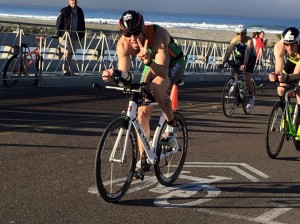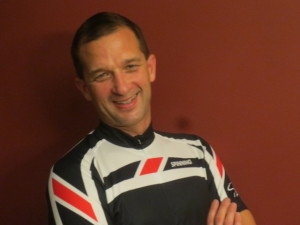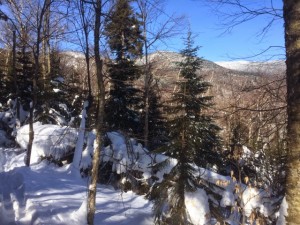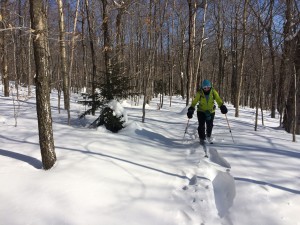Joey Adams, metabolic specialist and esteemed athletic coach, contributed the following to ‘ACTIVE VERMONT’ on March 29, 2015. Read on:
The pursuit of fitness has varying “rules”. Do this, try this, don’t do this, eat this, not this. Yet, where is the fun in any of that – in following someone’s dogma? So, without being dogmatic, I’d like to start with the concept of FUN in re-defining the pursuit of fitness.
When I think of the concept of fun, and the creation of my F rules (Fun-Focus-Flow-Fit-Form-Fuel-Fitness to avoid Fooey!) in pursuing fitness, I always use fun as the litmus test. As a true Vermonter, I think of Ben and Jerry and their famous quote, “if it is not fun, why do it?”
I then immediately think of the experience of watching my own children at play and now pursuing their own fitness passions. I’m captivated by their total immersion in their sports. It LOOKS like fun. You can see it on their faces and in their bodies’ expression.
So I offer you this, when it stops being fun, when you don’t look forward to your wellness pursuit in whatever form, it is time to stop and change course, shake it up, try something new. Get outside, try a new sport, take a new class, dance, move, play, create!
Even if you can’t do it YET, the key is a growth mindset. You can always learn, evolve and grow. It is in these moments that one can experience what Mihaly Csikszentmihalyi called FLOW. This is the moment of the autotelic experience, or of being immersed in the moment, a zen-like experience.
Eckhart Tolle would call it the “Power of Now” (1997). It is those experiences one has in the pursuit of a passion, of a time warp, where one loses the sense of time.
So if you’re working out and you find yourself looking at the clock, it is time to go back to the first F rule, time for some FUN. But, if you’re experiencing flow on a regular basis, move to the next F rule.
FIT. Your stuff has got to fit you. This comes down to EVERY contact point that your body makes with the ground or gravity or friction. I cannot tell you how many people who, when asked where they got their shoes, equipment, etc., and how they chose it, answered: “I got it online, it was a good color, or I thought it was the right one.” Inappropriate equipment leads to a path of injury through one’s endeavor. When a foot strike is wrong, a bike too big, or even a yoga mat too slippery, injuries and setbacks are waiting to happen.
This is where it makes sense to go to a local vendor, do research and spend time checking out what is right for you and your unique body.
For example, most running shoe fittings can take an hour or two to ensure you’ve got the right shoe (and the left one too). The clinician should have you run in multiple shoes on a treadmill and even do a video analysis to ensure proper fit that will enhance proper form.
Any equipment you buy should come with a warranty. If it doesn’t work for you, within reason, your provider should help you find what will and make the appropriate exchange.
Assuming things FIT, you’re now ready to work on FORM. Form is simply how you move in your endeavors. Do you move well, or are there imbalances? If you are a creature of the 21st century, you likely sit a lot, or have a job or life-demands that strengthen one part of the body over another. (I think about all those times I carried my kids around on one hip while doing something else with the other hand. Ouch.) It all adds up and translates to poor form caused by body asymmetries that derail your training. In addition, when you exercise, if you go at it too hard, you tend to favor strengths rather than addressing weaknesses, which in turn exacerbates weaknesses.
Think of the cognitive demands of Tai Chi, dance or any activity that requires precise form (which in actuality is everything, if done well).
Often the movement patterns developed as a basis, for the aforementioned activities, are done with slow movements first, adding on more complex patterns once those are mastered and then adding speed. So why start to sprint when you could walk, jog and then run?
It is during the slow pace that there is cognitive space to think about form. When I workout hard, form is the first thing to go; I’m just trying to survive. The body will follow the mind, not the other way around. A thought elicits a body response. We can be the masters of our thoughts and thus our movement and reactions.
F rules build a foundation, and now that you’ve grasped these, you’re ready for FUEL, repeatedly mistaken as the first rule. When people come to me for a metabolic test, they often think they have a slow metabolism. I’ve been assessing people’s metabolism for over a decade. In all that time I’ve tested less than three people (out of thousands) with slow metabolism, and those people were on very restrictive diets, unfortunately starving themselves fat.
For most people the key to weight management is to eat enough, eat early and often. Eat like a king or queen in the morning (it is called break-fast for a reason), a prince or princess in the afternoon (why the midday meal is biggest in many cultures), and a pauper in the evening (circadian rhythm slows and the body favors storing evening calories as fat).
The other concept to FUEL is to eat during exercise. Depending on your activity and intensity, if you know you’re going to exercise for more than 60-75 minutes, you need to eat 200-300 calories per hour. Too often I work with people who forget to eat during an event or workout and then pay the price towards the end.
Finally, after quantity and timing, remember to refuel post exercise. We are primal people, just a little better dressed than our paleolithic ancestors. But, at that stage of ancestral development we were either running to get food or running from being food according to the Paleo Diet for Athletes (even though I would argue no cookbooks survived from that time). Research supports eating within one half hour post exercise. It doesn’t have to be a lot; it could be a balanced meal as simple as fruit and nuts.
Fuel and timing help build the new, better, stronger you. Isn’t that one of the reasons why you do what you do?
Your F rules are in line. You’ve mastered and embraced FUN. You’ve discovered FOCUS that led to FLOW. Your gear finally FITS because of the guiding hands and eyes of a specialist. Your FORM is impeccably evolving and you are continually vigilant. You honor your FUEL needs. You have created a deeper FITNESS FOUNDATION.
The other choice, when any F gets out of balance is to just say Fooey (you could put in your favorite F word), but there’s good news. You then go back to FUN and start again, maybe in a new direction. When I was out of balance, I found yoga and meditation in my arsenal and I’m sure I will discover other fun things in my future.
Wishing you miles of smiles down your personal road to wellness, balance and peace…and as always, lots of fun!
Joey Adams, M.S. Exercise Science, Intelligent Fitness, Metabolic Specialist, VO2 assessments and performance analysis, www.intelligentfitnessvermont.com, “Getting workouts on target and making your time count.”
MEET JOEY ADAMS: Joey Adams, who has an M.S. in Exercise Science from Colorado State, is a Metabolic Specialist. “I specialize in assessing human performance and metabolism to help people make the most of their time by understanding their unique physiology,” Adams said. “My end game is to help people understand how their body works with the time and skills available to them.” Adams, who lives in Shelburne, travels throughout New England to test.
Meeting with Adams, one recognizes that there is more to his work than a job description. Adams finds a way to connect the nuts and bolts of training and teaching with the essence of humanity. For example, Adams teaches at Shelburne Community School and Champlain College where he “aspires to inspire kids to question everything around them, including authority, and prove everything they know so they can become the masters of their future.”
In his personal life, Adams is a devoted family man and generously dedicated to his students. “I’m an evolving compartmentalizer,” Adams said, “and stay true to my personal mission statement: Be true to myself, my family, and my students. Be present in each moment. Accept that I am human and try my best every day. In doing so I have the ability to create positive change.”
New research, new studies explained and books written, tout the importance of the mind-body connection to personal health and individual performance. Adams has ridden the crest of this wave. “For the past 5 years, the mind-body connection has been the driver for me,” Adams said. “This goes back to my earlier years working with corporate wellness. So many people think of their body as a vehicle to move their head from meeting to meeting rather than the interconnectedness between them.”
Adams prioritizes sleep hygiene as part of daily health and well-being. He practices yoga and meditation each several times a week, trains balance and functional movement, follows a vegan diet and lifestyle and the guidance of a naturopath. As a vegan he believes “that small changes than an individual makes can have a bit of global impact.”
These practices dovetail perfectly with the physical part of the equation and Adam’s expertise as a multi-sport athlete including cycling, cross-country skiing, skating… “ There’s not a sport I don’t love,” he said. “Currently it’s following my kids’ interests.”
Adams practices what he teaches and learns. By living an active lifestyle he relates to his students who yearn for more and to his clients who bring their hearts as well as bodies to the quest for higher performance. He models what he coaches and digs deep into mental and physical components of competition as well as daily life. [by – Linda Freeman]







